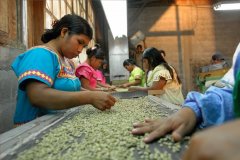Introduction of Sidamo coffee beans with clear acidity and smooth taste
Unlike most African coffees, sidamo has a clear acidity, a smooth texture, and a delicate floral aroma. Washed Sidamo is elegant and playful. The palate is mild and pleasant, with a strong impact of bright lemon acids later. The palate is unique and mellow, with a sweet and pleasant finish that rises slowly and contains unique sweetness. Green coffee beans are slightly gray, some places coarse and some places fine, acidity is soft and strong, alcohol density is appropriate, sweet and spicy, is one of the courtyard coffee in the southern highlands of Ethiopia.
Sidamo is a famous boutique coffee region in southern Ethiopia, bordering Kenya. Sitama treated by washing is light green, small beans, oval growth, full fruit, good average quality, fragrant and mellow, a drop of mouth, endless aftertaste, wild beauty, considered to be the thorny rose in coffee
Dara Zone, Sidamo
Producers Kebedo Local Smallholder Cooperative
Grade 3
solarization
Breed mix Native species (Heirloom)
Altitude 1800 to 2200 meters
The above information comes from Taiwan coffee blog "organic coffee blog".
From the bean shape, this bean is typical of Ethiopia, small particles, not very uniform size, color is typical of the sun treatment characteristics, so specially compared with Harald.
Sunlight Sidama Red Cherry Project (OCR)
The beans are similar in size, the color is fresher (indeed fresher, Harald is 11 years old, Sidamo is 11 years old), look at the beans, Sidamo is more careful, you can see the middle of the beans, and the defect rate is lower.

Important Notice :
前街咖啡 FrontStreet Coffee has moved to new addredd:
FrontStreet Coffee Address: 315,Donghua East Road,GuangZhou
Tel:020 38364473
- Prev

How to make a good cup of mixed coffee
Blending and roasting can not make a good Espresso without a good coffee mix. Coffee must be matched with the sweetness, aroma and lubrication required by Espresso. Coffee beans must be fresh, generally use coffee beans 4-7 days after roasting, which is conducive to the release of excess carbon dioxide from roasted beans, and coffee beans should be freshly ground to maintain freshness. At the same time, deeply baked beans will
- Next

Panamanian Coffee Indian Culture Mature Cherry Panamanian Coffee Unique Flavor
Since its early beginnings, Panama's coffee industry relies on the skilled hands of the Ngbe-Bugl Ngabe-Bugl Panamanian indigenous Indians, who for decades have migrated from their homelands to Mount Comarca to work on coffee farms located in the Baru volcano. Ngbe-Bugl Ngabe and Bugl are actually two different languages/indigenous groups whose languages are not mutually intelligible. The bigger Ngabe.
Related
- Does Rose Summer choose Blue, Green or Red? Detailed explanation of Rose Summer Coffee plots and Classification in Panamanian Jade Manor
- What is the difference between the origin, producing area, processing plant, cooperative and manor of coffee beans?
- How fine does the espresso powder fit? how to grind the espresso?
- Sca coffee roasting degree color card coffee roasting degree 8 roasting color values what do you mean?
- The practice of lattes: how to make lattes at home
- Introduction to Indonesian Fine Coffee beans-- Java Coffee producing area of Indonesian Arabica Coffee
- How much will the flavor of light and medium roasted rose summer be expressed? What baking level is rose summer suitable for?
- Introduction to the characteristics of washing, sun-drying or wet-planing coffee commonly used in Mantenin, Indonesia
- Price characteristics of Arabica Coffee Bean Starbucks introduction to Manning Coffee Bean Taste producing area Variety Manor
- What is the authentic Yega flavor? What are the flavor characteristics of the really excellent Yejasuffi coffee beans?

